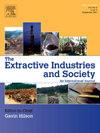Hydrosocial imaginaries of green extractivism: Water-energy transitions and geothermal lithium development at the Salton Sea in Imperial Valley, California
IF 3.6
2区 社会学
Q2 ENVIRONMENTAL STUDIES
Extractive Industries and Society-An International Journal
Pub Date : 2024-11-14
DOI:10.1016/j.exis.2024.101567
引用次数: 0
Abstract
Lithium is considered an “energy transition mineral” for mitigating climate change because it is a key component of batteries for electric vehicles and renewable energy storage. Even though it is framed as green, lithium mining has significant impacts on communities and ecosystems, especially in relation to water. This research takes a hydrosocial approach to examine the benefits and burdens of a proposed alternative method to avoid the harmful impacts of conventional lithium mining from brine evaporation or open-pit mining, by pairing geothermal energy production with direct lithium extraction (DLE) in the Salton Sea region of California. Government and industry proponents have framed this novel technology as an environmentally superior process, and boosters seek to transform the southeast edge of the Salton Sea in Imperial Valley into "Lithium Valley." We examine the emergence of green extractivism in Imperial Valley through three hydrosocial imaginaries: (1) reclamation; (2) restoration; and (3) recovery. Reclamation offers a lens through which to critically analyze the foundation of the Salton Sea, which is deeply rooted in colonialism, dispossession and industrialization. Restoration encompasses the environmental and public health impacts that a receding sea level and agro-industrial waste streams have on the region. Finally, geothermal lithium development has been framed by tech entrepreneurs, energy firms and resource managers as a process of “recovery” that would deliver community benefits and cleaner energy, while evading negative connotations of mineral “extraction.” Drawing from collaborative research and action for environmental justice, this study contributes to community engagement on the proposed Lithium Valley development.
绿色采掘的水社会想象:加利福尼亚帝国谷 Salton 海的水能转换和地热锂开发
锂被认为是减缓气候变化的 "能源转型矿产",因为它是电动汽车电池和可再生能源存储的关键组成部分。尽管锂矿被称为绿色矿产,但其开采对社区和生态系统,尤其是对水产生了重大影响。本研究采用水社会的方法,在加利福尼亚州的萨尔顿海地区,通过将地热能源生产与直接锂提取(DLE)相结合的方式,研究一种可避免传统卤水蒸发或露天开采锂矿的有害影响的替代方法的益处和负担。政府和行业支持者将这种新技术描述为一种环保型工艺,推动者试图将位于帝王谷的萨尔顿海东南边缘改造成 "锂谷"。我们通过三种水文社会想象来研究帝国谷绿色开采主义的出现:(1)开垦;(2)恢复;(3)复原。开垦为批判性地分析萨尔顿海的基础提供了一个视角,而这一基础深深植根于殖民主义、剥夺和工业化。恢复包括海平面下降和农业工业废物流对该地区环境和公共健康的影响。最后,地热锂的开发被科技企业家、能源公司和资源管理者称为 "恢复 "的过程,它将带来社区利益和更清洁的能源,同时避免矿物 "开采 "的负面含义。本研究借鉴了环境正义的合作研究和行动,有助于社区参与拟议的锂谷开发项目。
本文章由计算机程序翻译,如有差异,请以英文原文为准。
求助全文
约1分钟内获得全文
求助全文
来源期刊

Extractive Industries and Society-An International Journal
ENVIRONMENTAL STUDIES-
CiteScore
6.60
自引率
19.40%
发文量
135
 求助内容:
求助内容: 应助结果提醒方式:
应助结果提醒方式:


